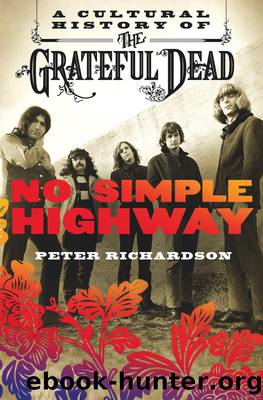No Simple Highway by Peter Richardson

Author:Peter Richardson
Language: eng
Format: epub
ISBN: 9781250021335
Publisher: St. Martin's Press
PART 3
COMMUNITY
When news of the Jonestown massacre hit, the Grateful Dead were in Washington, DC, where a Washington Post headline (“Still Grateful: Their Decade Died, the Dead Did Not”) cast them as a durable symbol of the 1960s. The story depicted Rock Scully offering the band a muddled report on Jonestown, but mostly it featured Garcia answering what had become standard questions about drugs, business practices, and the differences between the 1970s and the 1960s. “We were still tilting at windmills,” Garcia told the Post about their challenges with managers and record companies. “We found ourselves in trouble with the straight world and realized, ‘Wow, we’re not very good at this.’” Nevertheless, Garcia reported that the Dead and their community were flourishing. “The seventies are depressing all right,” he said. “But in the Grateful Dead world, things are snapping right along.”
Garcia had a point. The nation was experiencing what President Jimmy Carter called a crisis of confidence, but the Dead were doing as well as ever, despite the fact that the press consistently presented them as yesterday’s news. “It seems so long ago,” The Miami Herald reflected when the Dead came to town in 1977.
San Francisco’s Haight-Ashbury district. The word “psychedelic.” Tom Wolfe on what were the “acid tests.” And the Grateful Dead. Most of it has disappeared. No one talks about Haight-Ashbury anymore. Psychedelic posters have gone the way of peace pendants. Tom Wolfe writes about a different culture now. But the Grateful Dead aren’t gone; not yet.
A steady stream of press accounts recycled phrases that stressed the band’s longevity: the Dead were “alive and well,” “still truckin’ along,” “an undying rock institution,” and “untouched by age.” That emphasis usually implied nostalgia, and even positive concert reviews struck that note. “In a way, the Dead are an anachronism,” the Chicago Tribune noted. “But if they are not among rock’s most ‘relevant’ acts, they are one of its most durable delights—and chances are they’ll still be trucking when a lot of today’s trendies are forgotten.” Much of the coverage was also faintly condescending. “Apparently, falling in love with the Grateful Dead has become part of growing up, like acne or first sex,” the Chicago Sun-Times observed. For the media, the Dead had become not only a symbol of the 1960s, but also a monument to that turbulent decade.
A fresher story line featured the Dead Heads, a growing number of whom were following the tours. That phenomenon was unprecedented in American popular music but consistent with the band’s artistic roots. Kerouac and Kesey had evoked the romance of the open road, but only so many passengers could fit in Cassady’s sedan or Kesey’s bus. As the Dead crisscrossed the country playing large venues, they expanded the social space for the expression and transmission of countercultural values. The Dead Heads who swelled that progress were easy to spot and stereotype in the mainstream media. As Blair Jackson noted, they were typically presented as “stoned, tie-dye-wearing, VW-van-driving, stringy-haired, patchouli-scented, weirdly named, monosyllabic crazies who sell veggie burritos and crystals.
Download
This site does not store any files on its server. We only index and link to content provided by other sites. Please contact the content providers to delete copyright contents if any and email us, we'll remove relevant links or contents immediately.
| Classical | Country & Folk |
| Heavy Metal | Jazz |
| Pop | Punk |
| Rap & Hip-Hop | Rhythm & Blues |
| Rock |
Cecilia; Or, Memoirs of an Heiress — Volume 3 by Fanny Burney(30929)
Cecilia; Or, Memoirs of an Heiress — Volume 2 by Fanny Burney(30886)
Fanny Burney by Claire Harman(25779)
We're Going to Need More Wine by Gabrielle Union(18067)
Plagued by Fire by Paul Hendrickson(16632)
Cat's cradle by Kurt Vonnegut(13857)
Bombshells: Glamour Girls of a Lifetime by Sullivan Steve(13102)
All the Missing Girls by Megan Miranda(12741)
Leonardo da Vinci by Walter Isaacson(11897)
4 3 2 1: A Novel by Paul Auster(11035)
Adultolescence by Gabbie Hanna(8138)
The remains of the day by Kazuo Ishiguro(7543)
Note to Self by Connor Franta(7023)
Diary of a Player by Brad Paisley(6865)
Giovanni's Room by James Baldwin(5873)
What Does This Button Do? by Bruce Dickinson(5522)
Recovery by Russell Brand(4560)
Born a Crime by Trevor Noah(4508)
The Kite Runner by Khaled Hosseini(4417)
